Tags
Drugs, guerilla warfare, paramilitary presence, civil discontent (and, OK, Sofia Vergara) – these are a few of the stereotypes that pop into people’s minds when Colombia is mentioned. These days, however, visitors are more likely to encounter these themes on the walls of the country’s capital, Bogotá, where the acceptance of street art has made this vibrant city a mecca for grafiteros and painters from here and abroad.

In recent years, the city has adopted a remarkably permissive attitude toward street art and even “lesser” graffiti forms like tagging. Removing the threat of arrest has meant, among other things, more and better art. Being able to work during the day instead of under the cover of night has allowed artists better conditions in which to create, and some building owners have even commissioned murals to protect their property from tagging and more mundane scrawling.
Even those tags and scribbles are seen as art by some, including our tour guide. One of the highlights of our recent trip to Colombia was the Bogota Graffiti Tour in the old city neighborhood of La Candelaria, led by one of the city’s better-known street artists. (Although he divulged his identity to us at the end of the tour, we were asked not to use his name because of the sensitive political nature of some of his work.) According to him, we cannot have the “fine art” on the walls without the typical graffiti, and neither is more beautiful or worthy than the other.
Sometimes, in fact, art springs from the tags, the first and easiest entrée to the graffiti community. Walls can morph from a sprayed name to a painting, with others joining in with stencils, stickers, more tags, and more painting. The art is alive and dynamic, and the resulting collages can be among the most colorful walls in the neighborhood.
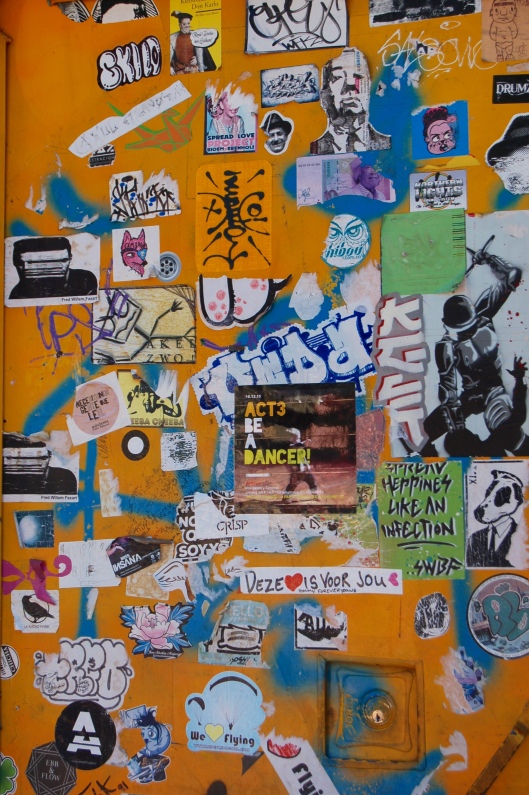
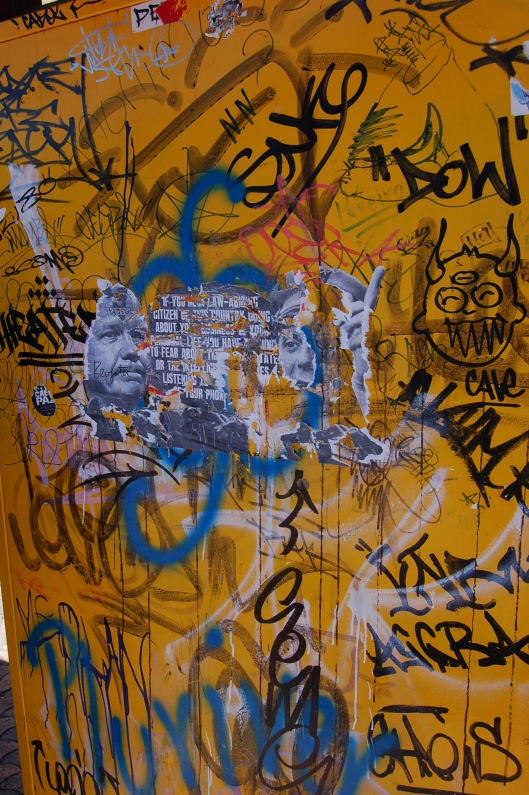
Bogota’s street art covers a wide range of subjects, but there is a prominent focus on the country’s social and political problems. For example, the long-running conflict between the government and left-wing guerrilla groups, as well as U.S. interventionist programs like Plan Colombia, have resulted in the internal displacement of millions of people (second only to Syria, to my surprise). Portraits of indigenous people – those most often displaced – are widespread, and country lifestyles are celebrated.

Environmental concerns are another popular theme; colorful birds and native animal species fly and crawl across the walls while oil rigs masquerade as gallows, stranglers of Colombia’s natural resources and celebrated biodiversity, and additional agents of displacement for humans as well as animals.

The homeless are memorialized as well, with one wall depicting the likeness of a man who sits nearby on his longtime home corner. Another homeless citizen is shown with a bag over his head, symbolizing the anonymity of this population.

Praxis
The FARC and land mines. Pollution and GMO crops. A tour of Bogota’s street art scene provides a basic education in Colombian politics, as well as its social, art, and literary history.
But some work is just for the fun and beauty of it; pitted walls are spruced up in bright colors and designs, and bright flora and fauna grow and live in the gritty old streets of La Candelaria.
Prominent artists include Rodez, Pez, DJ Lu, CRISP, Guache, GHB, Praxis, Stinkfish, and APC (a collective started by Stinkfish), among many others. A few samples:
RODEZ
PEZ
STINKFISH

DJ Lu
CRISP


GUACHE
I could post hundreds of other photos, but I’ll close with just two more of my favorites:



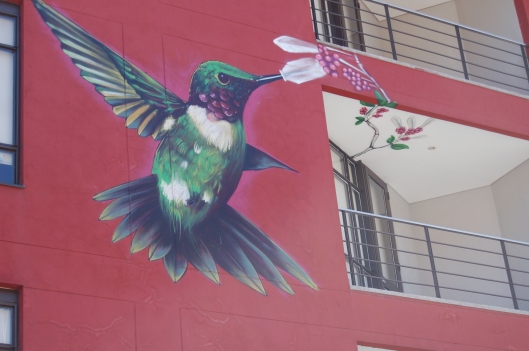
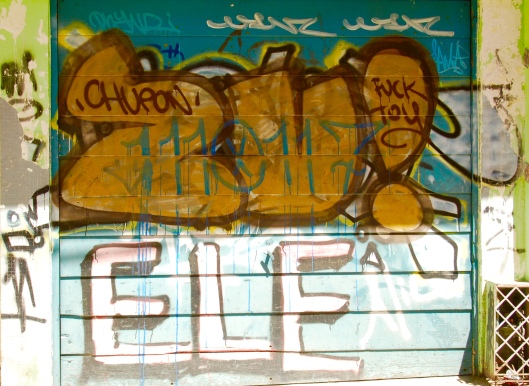







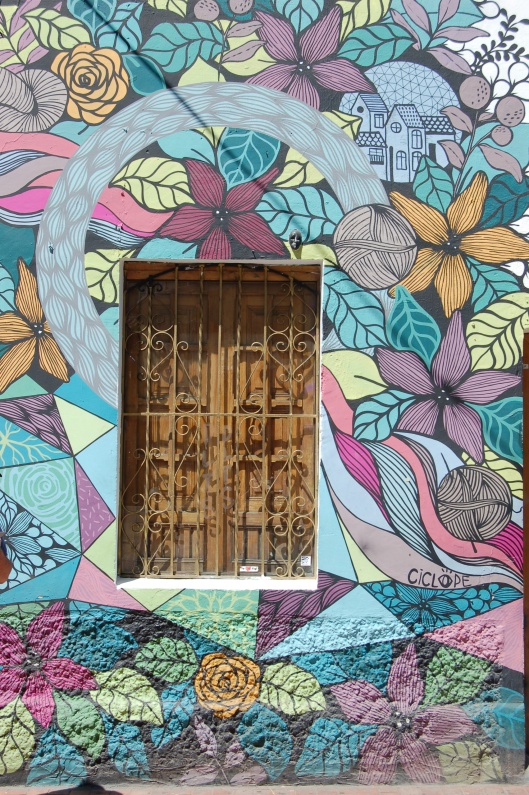
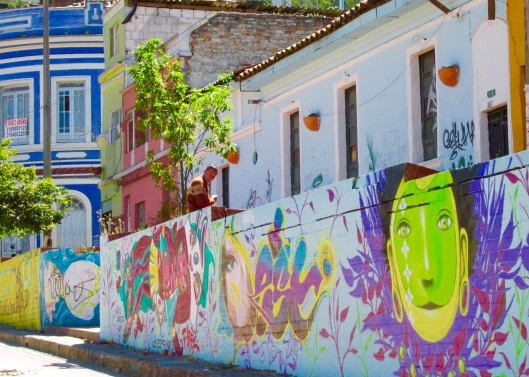




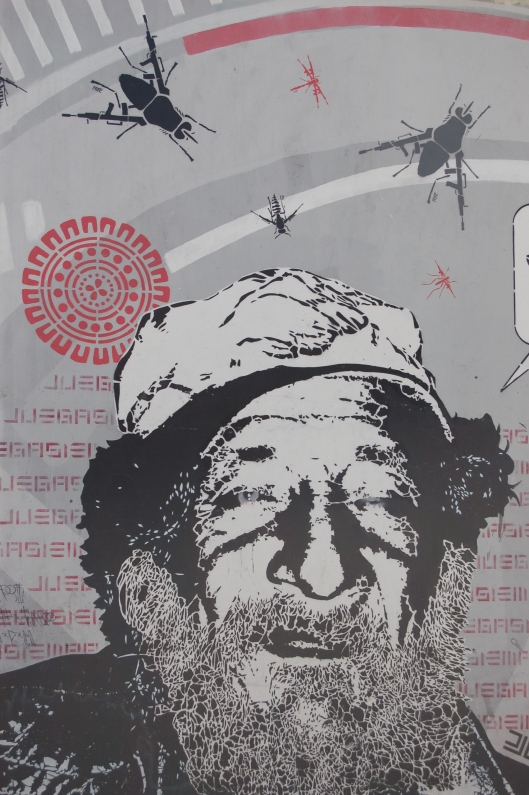






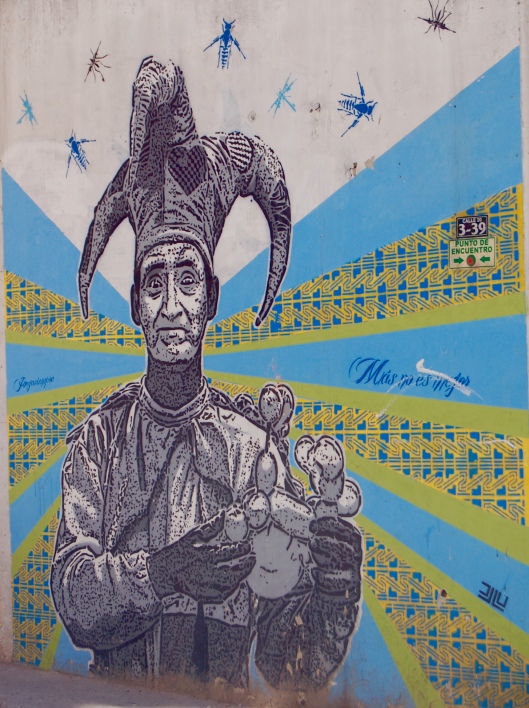




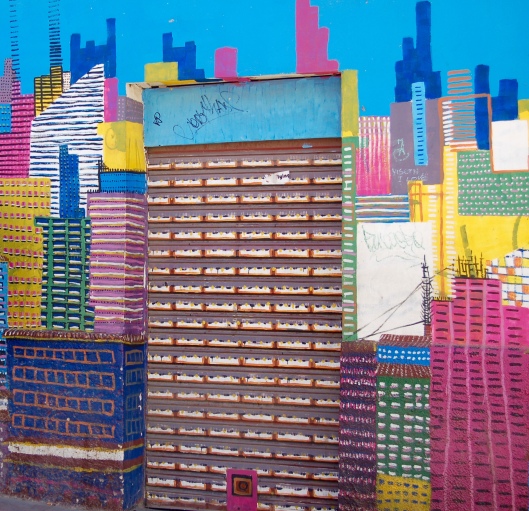
Love the art! Great post!
LikeLiked by 1 person
Thanks! The hardest part about writing this post was selecting the photos to highlight. I took hundreds! It was a fabulous tour.
LikeLike
Lexi this is by far my most favorite posts of yours! It is fabulous with so much color, culture, history and art. I love it so much that I saved it in my inbox to read again in the big computer. How fantastic! I love street art too and am amazed by the quality of this work. What does tagging mean? Sounds like a fantastic tour.
LikeLiked by 1 person
Thanks a lot! It was a fantastic morning – a 3-hour walk through the city, with so much to learn and see. It was also a gorgeous day, which always helps!
Tagging is when people leave their “tags,” or personal signatures, on a building or wall or whatever. It could be a spray painted name, initials, symbol, etc. Tagging is seen everywhere because it can be done quickly and furtively, so in places where graffiti is illegal, it is even more prevalent. In Bogota, there is still lots of tagging by local young people (mostly guys) who want to get their names out there, but the artists who paint full scenes or detailed drawings thrive here because they can work without the fear of being arrested.
LikeLiked by 1 person
Thanks Lexi for the explanation. I would really love to go to Colombia. I bet the trip was fascinating!
LikeLiked by 1 person
Fantastic photo journalism Lexi. I am always distracted by the art and the color and don’t spend enough time exploring the message as you have done so brilliantly here. The stand outs for me is the work of DJ Lu and the second to last image in the post. And I was VERY surprised to learn that Columbia is second only to Syria with displaced people. I’ve never heard that. Brilliant!
LikeLiked by 1 person
The Brilliant was referring to the art, not the displaced people. That is definitely not brilliant.
LikeLiked by 1 person
Thanks, Lisa! Isn’t that internally displaced people (IDP) ranking shocking?! Syria has 7.6 million IDPs, Colombia just over 6 million, and the next closest is Iraq, with “only” 3.4-ish million.
DJ Lu is not only prolific, but so talented. The detail is incredible in his larger paintings, but he may be best known for the small stencils (6 are in the mini-gallery) he uses to make political points. The hand grenade/pineapple mash-up is his also – a pretty potent statement.
I also absolutely loved that 2nd-to-the-last piece! It is part of a much larger wall, but that section really stood out to me.
LikeLiked by 1 person
Fantastic collections of photos. I love street art. It tells a story unique to the city in which it appears.
LikeLiked by 1 person
Agreed. And particularly here, where artists have the time to craft a vision or statement and carry it out. But I guess I just learned that even the quick sprays and tags can tell a story, making them just as unique to a place.
LikeLike
I didn’t realise Bogota was safe now. Were you tempted to tag your blog title, Lennon Wall style?
LikeLiked by 1 person
Ha – I never even thought about scribbling the blog name on Bogota’s walls! You must be a street artist at heart while I am a mere observer! Yes, Colombia is really pretty safe in most places now. Out in the jungles, mountains, and isolated rural areas, there are still pockets of guerrilla groups, unrest, and potential danger to tourists, but we were in the capital and Cartagena, an old walled city on the Caribbean, for most of the trip. Never felt the least bit worried anywhere, and we walked all over Bogota through every sort of neighborhood on our own.
LikeLike
Wow! Fabulous. I would love to see this though I must admit Colombia is not high on out list at the moment. Thanks for sharing.
Alison
LikeLiked by 1 person
Thanks! I do think you’d find the country a photographer’s dream, though …! There’s natural beauty, colorful wildlife, art on the walls and elsewhere, beautiful people, decaying old structures, seas and mountains … OK, maybe still not high on your list, but if it’s ever in your path, do go there!
LikeLiked by 1 person
This is real art, and thanks for giving all those elements of contexts. I would have missed most of the meanings. As much as I really don’t like graffiti, I am fascinated by the pure master pieces painted on those walls. It seems like wandering in an art gallery. I have always wondered how long the artist would take to make such a beautiful painting, knowing that the police could come anytime…
I love the paintings of the indigenous and the ones of the birds are so meaningful, especially after knowing that Columbia was right after Syria in terms of IDPs. I had no idea the numbers were so high.
Thanks again for another great post!
LikeLiked by 1 person
I loved the art for the art’s sake also, but I’m so glad we did the tour to get the meaning and context. I would have missed most of that, too. And yes, wow, the IDP numbers are astonishing (and sad)! Thank YOU for another great comment! 🙂
LikeLiked by 1 person
Amazing! Love it all.
LikeLiked by 1 person
Thanks! It was fascinating to see and learn about!
LikeLiked by 1 person
Some wonderful stuff here, thanks for sharing and offering the context.
LikeLiked by 1 person
Thanks, and you’re welcome! It’s nice to hear that this is enjoyable secondhand as well as in person. It was captivating, so I’m glad to see the appeal translates to photos and a little background story!
LikeLiked by 1 person
What a great post!!!
LikeLiked by 1 person
Thank you! Fun to see – fun to write about!
LikeLiked by 1 person
I liked this one so much that I tweeted it again. Truly a top post Lexi.
LikeLiked by 1 person
Thank you! It practically wrote itself with all that great art we saw and information we got. I’m having more trouble with posts on Cartagena and other things in Bogota – just hard to compare with all that good stuff!
LikeLiked by 1 person
Here in Scotland the law is really harsh on street art; and as a consequence the standard of ‘art’ on display is miserable. I have honestly seen the words “f*** you” scrawled on a concrete wall with a rock – spelled wrong 😦
LikeLiked by 1 person
Perhaps you can share with your leaders the Colombian philosophy that removing the threat of arrest will improve the art! It might brighten things up a bit! (Now that sounds negative about Scotland, which I love, so don’t take it that way!)
LikeLike
A good selection! 🙂 My daughter has stenciled a hummingbird quite similar to your first one on a cabinet in her bathroom. It always makes me smile 🙂
LikeLiked by 1 person
Thanks! Birds and beasts are always fun to see outside of their natural habitats! 🙂
LikeLiked by 1 person
Great post Lexie. I’m a big fan of street art, and have seen how it can improve the look of many neighborhoods. I like the murals best, and while I realize how creative tags are, too often they show up in places where they aren’t welcome. In my mind, it’s all about permission, and so many taggers never seem to get it. Back in the Pleistocene, I visited Colombia for my job. In those days, the FARC was kidnapping gringo oil company folks (like me) and holding them for ransom. On my last trip there I was traveling in the Magdalena Valley, and because it was a guerilla and narco area, I had to travel with a body guard – a very different travel experience. ~James
LikeLiked by 1 person
I remember that you had spent time there years ago. It was definitely much tamer for us; it’s hard to imagine what it must have been like back then when the guerrillas and drug organizations were running things.
LikeLike
Very colourful !
LikeLiked by 1 person
Colorful and cheerful! The art really brightens up the city. Colombia is sunny and warm anyway, but in older, more worn neighborhoods, the street art can be a nice pick-me-up.
LikeLiked by 1 person
Thanks for sharing a very beautiful gallery of street art and for the accompanying narrative. Brilliant. You gave us an insightful your and an immersion on the country’s social, economical and political issues which inspired the artists.
I totally agree with you that Colombia is too many characterized by narco traffic and guerrilla, but the have no idea on what the country is really like.
Thank you so much, Lex. Photojournalism at its best.
LikeLiked by 1 person
Well, thank you, Lucile! It was a wonderful combination of a sunny day art tour and a good lesson on Colombia’s former and current situation. It really was the best intro to Colombia we could have imagined.
LikeLike
You’re welcome, Lex. A great combination indeed and we are lucky to enjoy it.
LikeLiked by 1 person
Pingback: Weekly Photo Challenge: Face | An Eye on the World
Thanks for sharing this information. I really look forward to this tour, now.
LikeLiked by 1 person
Glad you found it and that you might try it! It was our favorite thing we did in Bogota. I wrote more notes and stuff on the other blog where you commented. Enjoy Bogota!
LikeLike
Pingback: Out with the Old, In with the New! | One Foot Out the Door
Pingback: Weekly Photo Challenge: Collage | An Eye on the World
What a lovely post. Did you also read this article In the Guardian 2 months after you posted?: https://www.theguardian.com/cities/2016/mar/09/bogota-state-sanctioned-street-art-crackdown-new-mayor
I like Bogota and I hope to return there sometime soon and check out the wonderful street! Wherever I go in the world I like to wander around and enjoy the public art, whether it is commissioned or not!
LikeLiked by 1 person
Wow – I had not read that, and it contains so many of the same images and artists I featured! Public art is a tough topic when it comes to graffiti; some people see it as enlivening and beautifying an area, and others see it as blight. It’s a tough call for an elected official!!
LikeLike
I agree! I can appreciate why some property owners commission murals rather than become victims of random tagging
LikeLiked by 1 person